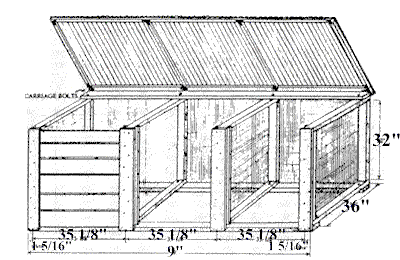

Do not use pressure-treated or chemically-treated wood for your compost bin.
TOOLS
Handsaw or circular power saw
Drill with 1/2" and 1/8" bits
Screwdriver
Hammer
Tin snips
Tape Measure
Pencil
3/4"
socket or open ended wrench
Carpenter's square
Safety glasses, ear
protection and dust mask
Cut two 31 1/2" and two 36" pieces from each 12' 2"x4". Butt end nail the four pieces into a 35" x 36" square. Repeat for the other three sections. Cut four 37" long sections of hardware cloth, and bend back the edges 1". Stretch the hardware cloth across each frame, check for squareness of the frame, and staple the screen tightly into place every 4" around the edge.
The dividers will be set parallel to one another and 3 feet apart. Measure and mark centre for the two inside dividers. Cut four 9' pieces out of the two 18' 2"x4" boards. Place two 9' base boards on top of the dividers and measure the positions for the two inside dividers. Mark a centre line for each divider on the 9' 2"x4". With each divider line up the centre lines and make the base board flush against the outer edge of the divider. Drill a 1/2" hole through each junction centred 1" in from the inside edge. Secure the base boards with carriage bolts, but do not tighten yet. Turn the unit right side up and repeat the process for the 9' board. Using the carpenter's square or measuring between opposing corners, make sure the bin is square, and tighten all bolts securely. Fasten a 9' long piece of hardware cloth securely to the back side of the bin with staples every 4" around the frame.
Cut four 36" long 2"x6"s for front slat runners. Rip cut two of these boards to 4 3/4" wide and nail them securely to the front of the outside dividers and baseboard, making them flush on top and outside edges. Save the remainder of rip cut for use as back runners. Centre the remaining full width boards on the front of the inside dividers flush with the top edge, and nail securely. To create back runners, cut the remaining 2"x6"s into a 34" long piece and then rip cut into 4 equal pieces, 1 1/4" x 34". Nail the back runner parallel to the front runners on side of divider leaving a 1" gap for slats. Cut all the 1"x6" cedar boards into slats 31 1/4" long.
Use the remaining 9' 2"x4"s for the back of the lid. Cut four 32 1/2" 2"x2"s and one 9' 2"x2". Lay out into position on the ground (as illustrated on the front) and check for squareness. Screw in the corner braces and T braces on the bottom side of the frame. Centre the lid frame, brace side down, on the bin structure and attach with hinges. Cut the wiggle board to fit the front and back 9' sections of the lid frame. Pre-drill the wiggle board with 1/8" drill bit and nail with 2 1/2" casement nails. Cut fibreglass to fit flush with the front and back edges. Overlay the pieces at least one channel wide. Pre- drill the fibreglass and wiggle board for each nail hole. Nail on top of every third hump with gasketed nails.
(This design sheet was originally produced for the Community Composting Education Program in Seattle, Washington).
Update June 1998.